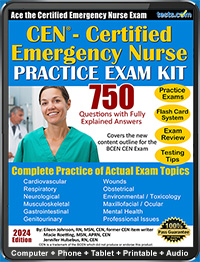2024 Edition
Emergency Nurse Certification Test
Take this free Emergency Nurse Certification practice test to give you an idea of the types of questions and sections on your actual CEN exam.
Quality starts with who wrote the material.
Our practice exam writer
s
:
Macie Roetting, MSN, APRN, CEN
Jennifer Hulsebus, RN, CEN
Eileen Johnson, RN, MSN
Jennifer Hulsebus, RN, CEN
Eileen Johnson, RN, MSN
A nurse who wishes to obtain the Certified Emergency Nurse (CEN) credential must take and pass the CEN exam which is administered by the Board of Certification of Emergency Nursing (BCEN).
The CEN exam tests your ability to use the Nursing Process within the context of Emergency Nursing. Throughout the test, you can expect to see questions that will test your assessment, analysis, intervention and evaluation knowledge. The CEN exam is composed of 175 multiple choice questions and covers the following twelve areas:
- Cardiovascular
- Respiratory
- Medical Emergencies and Infections
- Neurological
- Orthopedics and Wounds
- Gastrointestinal
- Genitourinary, Gynecological and Obstetrical
- Environment and Toxicology
- Professional issues
- Shock
- Maxillofacial and Ocular
- Psychosocial




